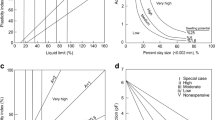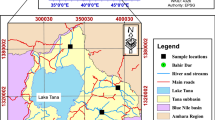Abstract
Lateral and vertical swelling pressures associated with expansive soils cause damages on structures. These pressures must be predicted before the structures are constructed in order to prevent the damages. The magnitude of the stresses can decrease rapidly when volume changes are partly allowed. Therefore, a material, which has a high compressibility, must be placed between expansive soils and the structures in both horizontal and vertical directions in order to decrease transmitted swelling pressure on structures. There are numerous techniques recommended for estimating the swelling pressures. However, these techniques are very complex and time-consuming. In this study, a new estimation model to predict the pressures is developed using experimental data. The data were collected in the laboratory using a newly developed device and experimental setup also. In the experimental setup, a rigid steel box was designed to measure transmitted swelling pressures in lateral and vertical directions. In the estimation model, approaches of artificial neural network (ANN) and adaptive neuro-fuzzy inference systems (ANFIS) are employed. In the first stage of the study, the lateral and vertical swelling pressures were measured with different thicknesses of expanded polystyrene geofoam placed between one of the vertical walls of the steel box and the expansive soil in the laboratory. Then, ANN and ANFIS approaches were trained using these results of the tests measured in the laboratory as input for the prediction of transmitted lateral and vertical swelling pressures. Results obtained showed that ANN-based prediction and ANFIS approaches could satisfactorily be used to estimate the transmitted lateral and vertical swelling pressures of expansive soils.








Similar content being viewed by others
Abbreviations
- a :
-
Scaling factor
- a i :
-
The parameter set which changes the shape of the MF degree
- A 1 :
-
MFs for inputs
- A 2 :
-
MFs for inputs
- AARE:
-
Average absolute relative error
- A i :
-
Linguistic fuzzy set associated with node
- ANFIS:
-
Adaptive neuro-fuzzy inference systems
- ANN:
-
Artificial neural network
- b :
-
Scaling factor
- B 1 :
-
MFs for inputs
- B 2 :
-
MFs for inputs
- b i :
-
The parameter set which changes the shape of the MF degree
- B i−2 :
-
Linguistic fuzzy set associated with node
- BPNN:
-
Back propagation neural network
- c i :
-
The parameter set which changes the shape of the MF degree
- e :
-
Vector of network errors
- EPS:
-
Expanded polystyrene
- FIS:
-
Fuzzy inference systems
- g :
-
Gradient
- H :
-
Hessian matrix
- i :
-
Layer
- j :
-
Layer
- J :
-
Jacobian Matrix
- J T :
-
Transpose of the Jacobian matrix
- k :
-
Layer
- LM:
-
Levenberg–Marquardt algorithm
- MFs:
-
Membership functions
- MLP:
-
Multi-layer perceptron
- N :
-
Number of data
- \( O_{1,\,i} \) :
-
Output of ANFIS
- P :
-
Swelling pressure
- p 1 :
-
The parameter of the output function of ANFIS
- p 2 :
-
The parameter of the output function of ANFIS
- P measured :
-
Measured swelling pressure
- P predicted :
-
Predicted swelling pressure
- q 1 :
-
The parameter of the output function of ANFIS
- q 2 :
-
The parameter of the output function of ANFIS
- r 1 :
-
The parameter of the output function of ANFIS
- r 2 :
-
The parameter of the output function of ANFIS
- R 2 :
-
Determination coefficient
- RE:
-
Relative error
- RMSE:
-
Root mean square error
- W :
-
Interconnection strengths, or weights
- \( W_{ij} \) :
-
Interconnection weights
- \( W_{jk} \) :
-
Interconnection weights
- x :
-
Input for ANFIS
- x k :
-
Parameter vector
- x k+1 :
-
Parameter vector
- \( x_{\hbox{min} } \) :
-
Minimum of the training and test data
- \( x_{\hbox{max} } \) :
-
Maximum of the training and test data
- y :
-
Input for ANFIS
- μ:
-
Membership grades
- μ Ai :
-
Membership grades of an input parameter
References
Ashayeri I, Yasrebi S (2009) Free-swell and swelling pressure of unsaturated compacted clays; experiments and neural networks modeling. Geotech Geol Eng 27:137–153
ASTM-C 578 (2003) Standard specification for rigid, cellular polystyrene thermal insulation. Annual Book of ASTM Standards C578, 04.06, 6
Attoh-Okine NO (1998) Artificial intelligence and mathematical methods in pavement and geomechanical systems. In: Proceedings of the workshop at Florida International University, North Miami, Florida, 5–6. Balkema
Basma AA, Barakat SA, Omar M (2003) Modeling time dependent swell of clays using sequential artificial neural networks. Environ Eng Geosci 9(3):279–288
Beinbrech G, Hillmann R (1997) EPS in road construction—current situation in Germany. Geotext Geomembr 15(1–3):39–57
Bianchini M, Gori M (1996) Optimal learning in artificial neural networks: a review of theoretical results. Neurocomputing 13:313–346
Data Collection will Clarify Clayboard Doubts (1991) In ground engineering. Thomas Telford, UK
Dawson WC, Wilby R (1998) An artificial neural network approach to rainfall-runoff modeling. Hydrol Sci J 43(1):47–66
Doris JJ, Rizzo MD, Dewoolkar MM (2008) Forecasting vertical ground surface movement from shrinking/swelling soils with artificial neural networks. Int J Numer Anal Methods Geomech 32:1229–1245
Goh ATC (1996) Neural-network modeling of CPT seismic liquefaction data. J Geotech Eng 122(1):70–73
Goh ATC, Wong KS, Broms BB (1995) Estimation of lateral wall movements in braced excavation using neural networks. Can Geotech J 32:1059–1064
Hagan MT, Menhaj M (1994) Training feedforward networks with the Marquardt algorithm. IEEE Trans Neural Netw 5(6):989–993
Haykin S (1999) Neural networks: a comprehensive foundation, 2nd edn. Prentice-Hall, Upper Saddle River, pp 26–32
Horvath JS (1997) The compressible inclusion function of EPS geofoam. Geotext Geomembr 15:77–120
Ikizler SB, Aytekin M, Nas E (2008) Laboratory study of expanded polystyrene (EPS) geofoam used with expansive soils. Geotext Geomembr 26(2):189–195
Ikizler SB, Aytekin M, Kocabaş F, Vekli M (2010) Prediction of swelling pressures of expansive soils using artificial neural networks. Adv Eng Softw 41(4):647–655
Jang JSR (1993) ANFIS: adaptive-network-based fuzzy inference system. IEEE Trans Syst Man Cybern 23(3):665–685
Jeon J (2007) Fuzzy and neural network models for analyses of piles. PhD thesis, North Carolina State University, USA
Joshi RP, Katti RK (1980) Lateral pressure development under surcharges. In: Proceedings of the 4th international conference on expansive soils, Denver, USA, pp 227–241
Lee C, Sterling R (1992) Identifying probable failure modes for underground openings using a neural network. Int J Rock Mech Min Sci Geomech Abstr 29(1):49–67
Lee IM, Lee JH (1996) Prediction of pile bearing capacity using artificial neural networks. Comput Geotech 18(3):189–200
Meisina C, Najjar Y (2004) An artificial neural network approach for predicting swelling/shrinking parameters of Italian clay soils. Eur Geosci Union Geophys Res Abstr 6:03295. http://www.cosis.net/abstracts/EGU04/03295/EGU04-J-03295.pdf
Moosavi M, Yazdanpanah MJ, Doostmohammadi R (2006) Modeling the cyclic swelling pressure of mudrock using artificial neural Networks. Eng Geol 87:178–194
Moré JJ (1977) Lecture notes in mathematics. The Levenberg–Marquardt algorithm: implementation and theory. In: Watson GA (ed) Numerical analysis, vol 630. Springer, Berlin, pp 105–116
Najjar YM, Basheer IA, McReynolds R (1996) Neural modeling of Kansan soil swelling. Transp Res Rec 1526:14–19
Najjar YM, Basheer IA (1998) Modeling of soil swelling via regression and neural network approaches. Final report, report no.: KS 98-1. Kansas Department of Transportation, p 37
Neocleous C, Schizas C (2002) Artificial neural network learning. A comparative review. Methods and applications of artificial intelligence, Lecture notes in computer science, vol 2308, pp 300–313
Riad HL, Ricci AL, Osborn PW, Horvath JS (2003) Expanded polystyrene (EPS) geofoam for road embankments and other lightweight fills in urban environments. Soil and rock America 2003. In: 12th Panamerican conference on soil mechanics and geotechnical engineering/39th US rock mechanics symposium, Cambridge, MA, USA, pp 1767–1772
Rizzo DM, Dougherty DE (1994) Application of artificial neural networks for site characterization using hard and soft information. In: Peters A et al (eds) Proceedings of the 10th international conference on computational methods in water resources, vol 12. Kluwer, Dordrecht, pp 793–799
Sivakugan N, Eckersley JD, Li H (1998) Settlement predictions using neural networks. Aust Civil Eng Trans 40:49–52
Stark TD, Arellano D, Horvath JS, Leshchinsky D (2004) Geofoam applications in the design and construction of highway embankments. NCHRP web document. Transportation Research Board, USA, p 65
Suykens JAK (2001) Nonlinear modelling and support vector machines. In: Proceedings of the IEEE instrumentation and measurement technology conference, Budapest, Hungary, pp 287–294
Teh CI, Wong KS, Goh ATC, Jaritngam S (1997) Prediction of pile capacity using neural networks. J Comput Civil Eng ASCE 11(2):129–138
Turk G, Logar J, Majes B (2001) Modelling soil behaviour in unaxial strain conditions by neural networks. Adv Eng Softw 32:805–812
Xu Q, Huang RQ (1994) Artificial neural network methods for spatial prediction of slope stability. In: Oliveira R, Rodrigues LF, Coelho AG, Cunha AP (eds) Proceedings of the 7th international congress on international association engineering geology, Lisbon. Balkema, Rotterdam, pp 4725–4728
Zarnani S, Bathurst RJ (2007) Experimental investigation of EPS geofoam seismic buffers using shaking table tests. Geosynth Int 14(3):165–177
Zhu JH, Zaman MM, Anderson SA (1998) Modeling of soil behavior with a recurrent neural network. Can Geotech J 35(5):858–872
Zou Y, Small JC, Leo CJ (2000) Behaviour of EPS geofoam in model test on pavements. Geosynth Int 7(1):1–22
Acknowledgments
The authors gratefully acknowledge the support given by the Turkish Polystyrene Manufacturers Association (PUD).
Author information
Authors and Affiliations
Corresponding author
Rights and permissions
About this article
Cite this article
Ikizler, S.B., Vekli, M., Dogan, E. et al. Prediction of swelling pressures of expansive soils using soft computing methods. Neural Comput & Applic 24, 473–485 (2014). https://doi.org/10.1007/s00521-012-1254-1
Received:
Accepted:
Published:
Issue Date:
DOI: https://doi.org/10.1007/s00521-012-1254-1




